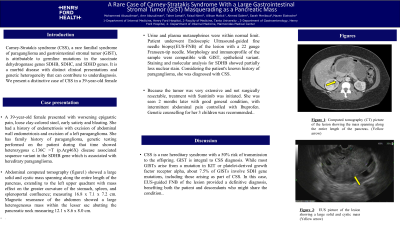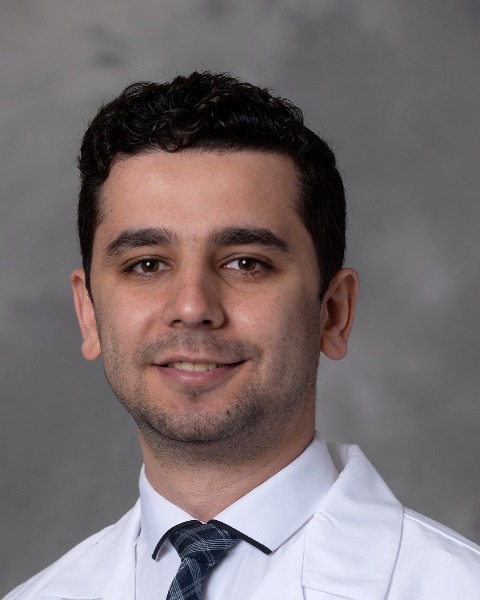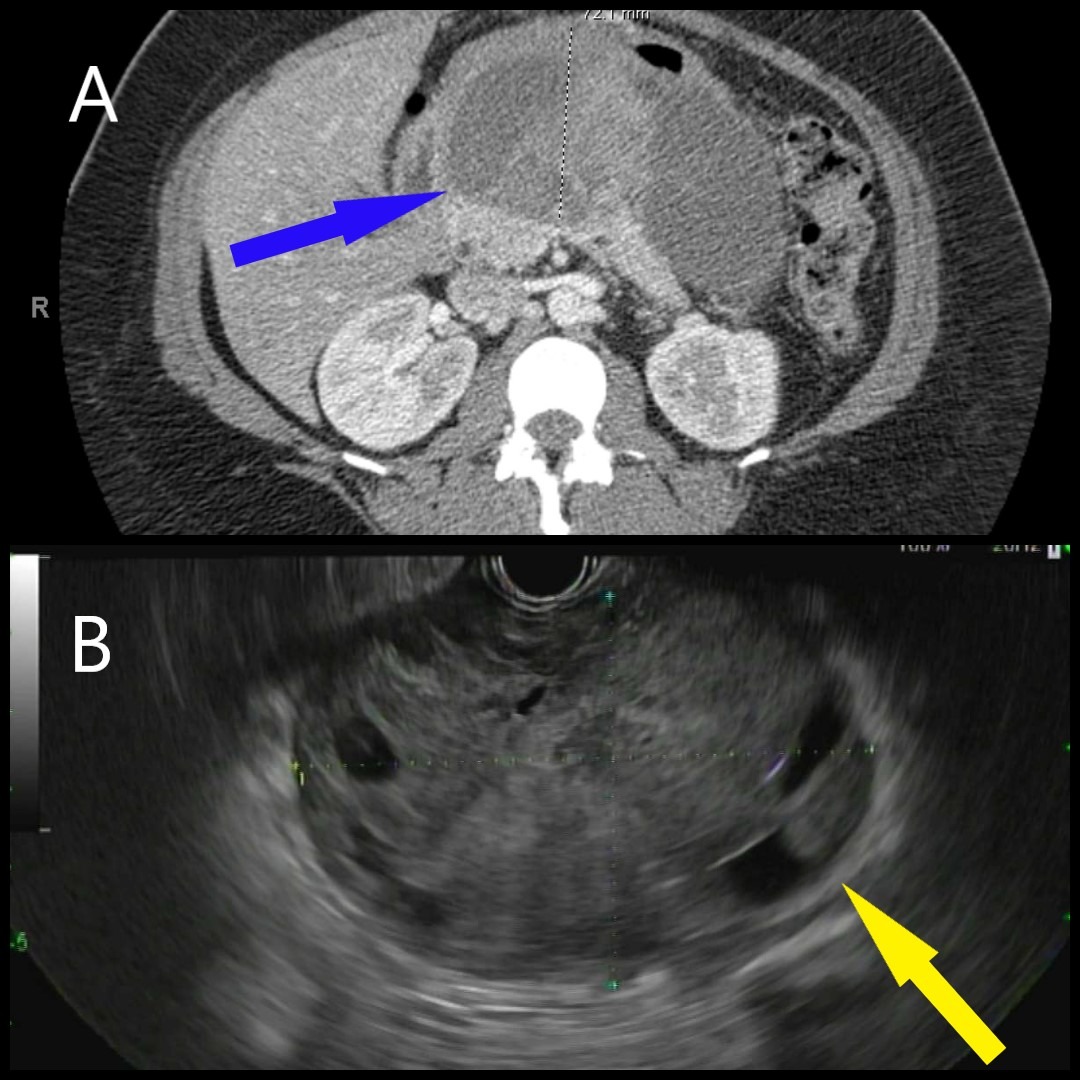Monday Poster Session
Category: Interventional Endoscopy
P2816 - A Rare Case of Carney-Stratakis Syndrome With a Large Gastrointestinal Stromal Tumor (GIST) Masquerading as a Pancreatic Mass
Monday, October 28, 2024
10:30 AM - 4:00 PM ET
Location: Exhibit Hall E

Has Audio

Mohammed Abusuliman, MD
Henry Ford Health
Detroit, MI
Presenting Author(s)
Mohammed Abusuliman, MD1, Amr Abusuliman, MD2, Taher Jamali, MD3, Faisal Nimri, MD3, Allison N. Malick, MD1, Ahmed Salem, MBBCh4, Sarah Meribout, MD4, Mazen Elatrache, MD5
1Henry Ford Health, Detroit, MI; 2Tanta University, Qutour, Al Gharbiyah, Egypt; 3Henry Ford Hospital, Detroit, MI; 4Maimonides Medical Center, Brooklyn, NY; 5Henry Ford Health, Dearborn, MI
Introduction: Carney-Stratakis syndrome (CSS), a rare familial syndrome of paraganglioma and gastrointestinal stromal tumor (GIST), is attributable to germline mutations in the succinate dehydrogenase genes SDHB, SDHC, and SDHD genes. It is a morbid disease with distinct clinical presentations and genetic heterogeneity that can contribute to underdiagnosis. We present a distinctive case of CSS in a 39-year-old female.
Case Description/Methods: A 39-year-old female presented with worsening epigastric pain, loose clay-colored stool, early satiety and bloating. She had a history of endometriosis with excision of abdominal wall endometriosis and excision of a left paraganglioma. She has family history of paraganglioma, genetic testing performed on the patient during that time showed heterozygous c.136C >T (p.Arg46X) disease associated sequence variant in the SDHB gene which is associated with hereditary paraganglioma.
Abdominal computed tomography (figure1) showed a large solid and cystic mass spanning along the entire length of the pancreas, extending to the left upper quadrant with mass effect on the greater curvature of the stomach, spleen, and splenoportal confluence; measuring 16.8 x 7.1 x 7.2 cm. Magnetic resonance of the abdomen showed a large heterogeneous mass within the lesser sac abutting the pancreatic neck measuring 12.1 x 8.6 x 8.0 cm.
Urine and plasma metanephrines were within normal limit. Patient underwent Endoscopic Ultrasound-guided fine needle biopsy(EUS-FNB) of the lesion with a 22 gauge Franseen-tip needle. Morphology and immunoprofile of the sample were compatible with GIST, epithelioid variant. Staining and molecular analysis for SDHB showed partially loss nuclear stain. Considering the patient's known history of paraganglioma, she was diagnosed with CSS.
Because the tumor was very extensive and not surgically resectable, treatment with Sunitinib was initiated. She was seen 2 months later with good general condition, with intermittent abdominal pain controlled with Ibuprofen. Genetic counselling for her 3 children was recommended.
Discussion: CSS is a rare hereditary syndrome with a 50% risk of transmission to the offspring. GIST is integral to CSS diagnosis. While most GISTs arise from a mutation in KIT or platelet-derived growth factor receptor alpha, about 7.5% of GISTs involve SDH gene mutations, including those arising as part of CSS. In this case, EUS-guided FNB of the lesion provided a definitive diagnosis, benefiting both the patient and descendants who might share the condition.

Disclosures:
Mohammed Abusuliman, MD1, Amr Abusuliman, MD2, Taher Jamali, MD3, Faisal Nimri, MD3, Allison N. Malick, MD1, Ahmed Salem, MBBCh4, Sarah Meribout, MD4, Mazen Elatrache, MD5. P2816 - A Rare Case of Carney-Stratakis Syndrome With a Large Gastrointestinal Stromal Tumor (GIST) Masquerading as a Pancreatic Mass, ACG 2024 Annual Scientific Meeting Abstracts. Philadelphia, PA: American College of Gastroenterology.
1Henry Ford Health, Detroit, MI; 2Tanta University, Qutour, Al Gharbiyah, Egypt; 3Henry Ford Hospital, Detroit, MI; 4Maimonides Medical Center, Brooklyn, NY; 5Henry Ford Health, Dearborn, MI
Introduction: Carney-Stratakis syndrome (CSS), a rare familial syndrome of paraganglioma and gastrointestinal stromal tumor (GIST), is attributable to germline mutations in the succinate dehydrogenase genes SDHB, SDHC, and SDHD genes. It is a morbid disease with distinct clinical presentations and genetic heterogeneity that can contribute to underdiagnosis. We present a distinctive case of CSS in a 39-year-old female.
Case Description/Methods: A 39-year-old female presented with worsening epigastric pain, loose clay-colored stool, early satiety and bloating. She had a history of endometriosis with excision of abdominal wall endometriosis and excision of a left paraganglioma. She has family history of paraganglioma, genetic testing performed on the patient during that time showed heterozygous c.136C >T (p.Arg46X) disease associated sequence variant in the SDHB gene which is associated with hereditary paraganglioma.
Abdominal computed tomography (figure1) showed a large solid and cystic mass spanning along the entire length of the pancreas, extending to the left upper quadrant with mass effect on the greater curvature of the stomach, spleen, and splenoportal confluence; measuring 16.8 x 7.1 x 7.2 cm. Magnetic resonance of the abdomen showed a large heterogeneous mass within the lesser sac abutting the pancreatic neck measuring 12.1 x 8.6 x 8.0 cm.
Urine and plasma metanephrines were within normal limit. Patient underwent Endoscopic Ultrasound-guided fine needle biopsy(EUS-FNB) of the lesion with a 22 gauge Franseen-tip needle. Morphology and immunoprofile of the sample were compatible with GIST, epithelioid variant. Staining and molecular analysis for SDHB showed partially loss nuclear stain. Considering the patient's known history of paraganglioma, she was diagnosed with CSS.
Because the tumor was very extensive and not surgically resectable, treatment with Sunitinib was initiated. She was seen 2 months later with good general condition, with intermittent abdominal pain controlled with Ibuprofen. Genetic counselling for her 3 children was recommended.
Discussion: CSS is a rare hereditary syndrome with a 50% risk of transmission to the offspring. GIST is integral to CSS diagnosis. While most GISTs arise from a mutation in KIT or platelet-derived growth factor receptor alpha, about 7.5% of GISTs involve SDH gene mutations, including those arising as part of CSS. In this case, EUS-guided FNB of the lesion provided a definitive diagnosis, benefiting both the patient and descendants who might share the condition.

Figure: Figure 1: Computed tomography (CT) picture of the lesion showing the mass spanning along the entire length of the pancreas (Panel A, blue arrow). EUS picture of the lesion showing a large solid and cystic mass (Panel B, yellow arrow)
Disclosures:
Mohammed Abusuliman indicated no relevant financial relationships.
Amr Abusuliman indicated no relevant financial relationships.
Taher Jamali indicated no relevant financial relationships.
Faisal Nimri indicated no relevant financial relationships.
Allison Malick indicated no relevant financial relationships.
Ahmed Salem indicated no relevant financial relationships.
Sarah Meribout indicated no relevant financial relationships.
Mazen Elatrache indicated no relevant financial relationships.
Mohammed Abusuliman, MD1, Amr Abusuliman, MD2, Taher Jamali, MD3, Faisal Nimri, MD3, Allison N. Malick, MD1, Ahmed Salem, MBBCh4, Sarah Meribout, MD4, Mazen Elatrache, MD5. P2816 - A Rare Case of Carney-Stratakis Syndrome With a Large Gastrointestinal Stromal Tumor (GIST) Masquerading as a Pancreatic Mass, ACG 2024 Annual Scientific Meeting Abstracts. Philadelphia, PA: American College of Gastroenterology.
